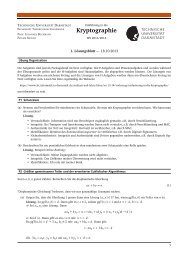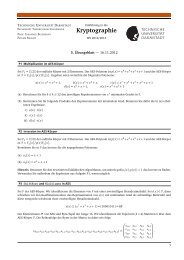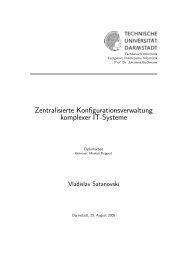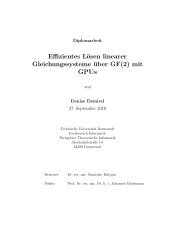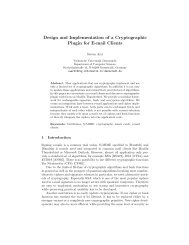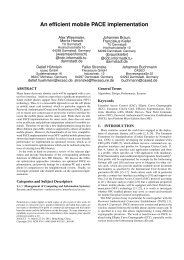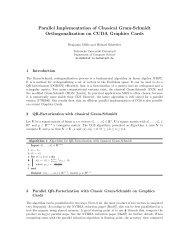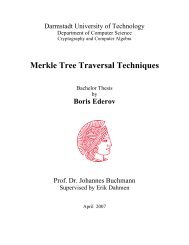Lattice Basis Reduction in Infinity Norm - Technische Universität ...
Lattice Basis Reduction in Infinity Norm - Technische Universität ...
Lattice Basis Reduction in Infinity Norm - Technische Universität ...
Create successful ePaper yourself
Turn your PDF publications into a flip-book with our unique Google optimized e-Paper software.
3. END WHILE<br />
– IF νt = 0<br />
– THEN<br />
∗ ∆t := −∆t<br />
∗ IF ∆tδt ≥ 0 THEN ∆t := ∆t + δt<br />
– ELSE ∆t := ∆t + δt<br />
– ũt := νt + ∆t<br />
OUTPUT: (u1, ...., um), c = � � m<br />
i=1 uibi �p<br />
The algorithm SCHNITTp works <strong>in</strong> the follow<strong>in</strong>g way:<br />
Algorithm 3.5 SCHNITTp<br />
INPUT: s, ωt, ...., ωs, ˜ct, ...., ˜cs, c<br />
1. Compute the m<strong>in</strong>imum F of the function<br />
f(λt, ...., λs) := c � �s i=t λiωi �q − �s i=t λi˜ci with respect to a<br />
subgroup of the vectors (λt, ...., λs) with λt > 0 and �s i=t λi˜ci > 0).<br />
The most efficient constra<strong>in</strong>t <strong>in</strong> practice is (λt, ...., λs) = (1, 0, ...., 0)<br />
OUTPUT: 1, if F < 0 and 0 otherwise<br />
ηt shows <strong>in</strong> how many directions the enumeration process of step t was<br />
broken. If ηt = 1 and SCHNITTp(....) = 1 holds, then both directions can<br />
be broken, which means that t can be <strong>in</strong>creased by 1. By always choos<strong>in</strong>g<br />
a positive ũs the redundancy of the enumeration process could be avoided.<br />
Thus at step s only one of the directions needs to be processed and ηs can<br />
be <strong>in</strong>itialized directly with 1. Here c is the lp-norm of the shortest lattice<br />
vector.<br />
The number of the knots, which are traversed throughout the<br />
ENUM(j, k) algorithm , is proportional to the volume of the set, <strong>in</strong> which<br />
the orthogonal vectors ωt lie. Without the algorithm SCHNITTp the set<br />
is simply the l2-norm ball Sn(0, R(� · �p) � ¯ b �p). Through the constra<strong>in</strong>t<br />
(λt, ...., λm) = (1, 0, ...., 0) the restra<strong>in</strong>t � x � 2 2 ≤ � ¯ b �p� x �q, for x ∈ R n ,<br />
is reached. For l∞-norm this restra<strong>in</strong>t means a decrease of the volume with<br />
an exponential factor. The cost of this step is l<strong>in</strong>ear.<br />
5.4 Enumeration for Inf<strong>in</strong>ity <strong>Norm</strong><br />
We consider here the case of lattices consist<strong>in</strong>g only of <strong>in</strong>tegers. The l∞norm<br />
of the shortest lattice vector is therefore also an <strong>in</strong>teger and s<strong>in</strong>ce<br />
R(� · �p) = √ n˜ct < (R(� · �∞ c)) 2 , it can be replaced by ˜ct ≤ n(c − 1) 2 .<br />
In practice often only l∞-norm equal to 1 is wanted. In such cases c<br />
could be <strong>in</strong>itialized with 2 and the enumeration is completed as soon as<br />
such a norm is found. Thus a determ<strong>in</strong>istic algorithm is found with which<br />
all Knapsack problems with dimension up to 66 can be efficiently solved.<br />
28





